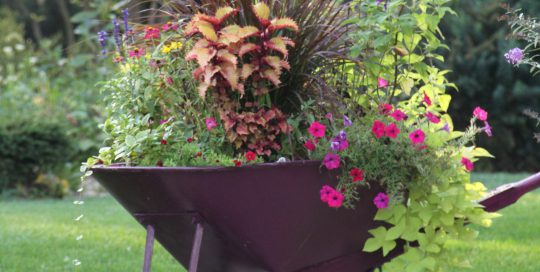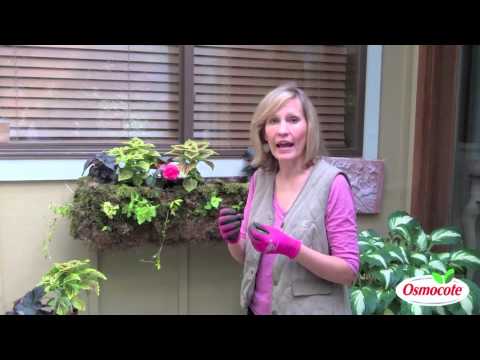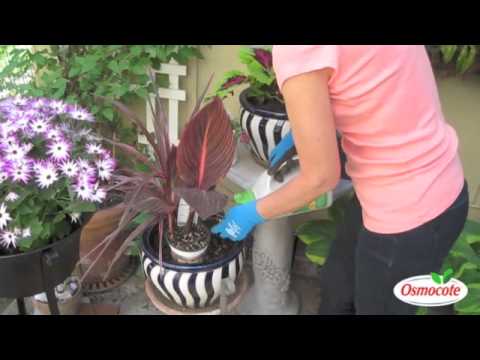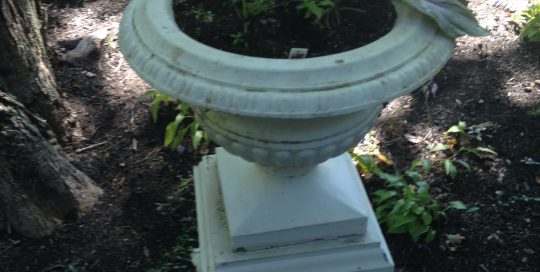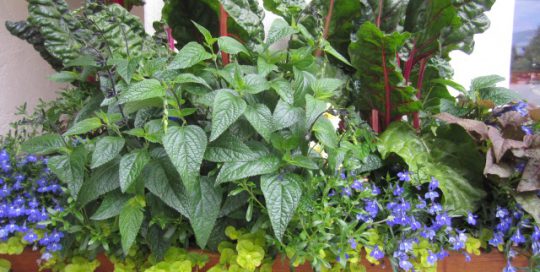Thriller, Fillers and Spillers
I have a simple recipe for designing my containers — I try to use one each of three types of plants. I call the plant types, ‘thrillers’, ‘fillers’ and ‘spillers’. ‘Thrillers’ are plants such as ornamental grasses, large salvias or canna lilies. ‘Fillers’ can be calibrachoa, zinnias or begonias. ‘Spillers’ are trailing plants — bacopa, petunias or ivy. I like hot colors, so flowers or leafy shapes that grab my attention are preferenced.
I often start the season with pansiesbecause of the tolerance of cold temperatures. When it’s time to change them out, instead of consigning them straight to the compost pile, I prefer to transfer them to the edge of my shade garden where they often bloom again in the fall when the weather is cool. As a replacement, I look to one of my favorite long-blooming annuals, the Zinnia‘Profusion Cherry’. This compact plant blooms non-stop all summer and needs no care other than watering and fertilizing.
In some containers, I plant the lovely blue-flowered Salvia ‘Mystic Spires’as my ‘thriller’. The plant grows about three feet tall or more and attracts hummingbirds, bees and butterflies. Around the edge of the container, I pop in some Wave petuniasto serve as my ‘spillers’ by trailing over the sides. Both of these annuals are easy-care, long bloomers that take my containers right into September.
If I’m working on a container with edibles, Bronze fennelis a favorite ‘filler’ that I pop into large containers. Its dark, delicate and feathery leaves serve as a host plant for swallowtail butterflies, so that’s a real bonus. Tomato plants will fit into a few 17-gallon plastic tubs. Sow seeds of basil around the inside edge of the pots. It makes for an easy harvest in summer when I’m making salads or a pizza on the grill. Other herbs, such as dill and parsley make great ‘fillers’ in pots alongside flowers.
Color Combos
A gardener’s art lies in creating a colorful arrangement of flowers and foliage that harmonize and complement one another. A planting of beefy burgundy-leaved cannas, orange zinnias, red-leaved fountain grass, salmon calibrachoa and bronze-leaved coleus makes for a hot-colored tapestry that feels tropical and exotic. At the other extreme is a grouping of pale blue ageratum, pastel pink roses and white sweet alyssum, which creates a cool, soothing, classical English-garden combination.
Let’s consider the color wheel, which can help hone the hues in your container plantings. A very basic color wheel is composed of six colors: primary colors, which are red, yellow and blue, and secondary colors, which are green, orange and violet.
Complementary colors are those that are directly opposite one another on the color wheel, such as red and green, orange and blue, yellow and violet.
Combine complementary colors, such as yellow achillea or marigolds and violet salvia and both become more vibrant and intense than when they are grouped alone. Harmonious colors are those that appear next to one another on the color wheel such as green and blue, yellow and white, red and orange.
It’s often difficult to get great flower color in a shade garden, and that’s where a container (or two or three) set amongst hostas, ferns and other ground covers can create a splash. Red-flowered begonias or geraniums create a focal point because of the red-and-green color combination. Those complementary colors simply pop.
Caladiums in containers also look good in the shade garden. Set the containers up on a pedestal or bricks so the pots are up and above the ground covers. The large colorful caladium leaves in red, green, white and burgundy take the place of flowers.
Container Gardening Trends
One of the hottest trends right now are succulentsplanted in pots. Succulents, like jade plant and aloe, tend to have thick leaves that hold water and help the plant resist drought. Many types of Echeveriahave dusty or steel blue leaves while Aeoniummay form a rosette of chartreuse leaves edged in red. Agave also has a pale blue leaves edged in maroon or black with tiny spines. One of my favorites succulents is baby toes (Andromischus cristata), which looks like little plump feet. These plants need well-drained soil, indirect light and infrequent watering. At the end of summer, I bring them indoors.
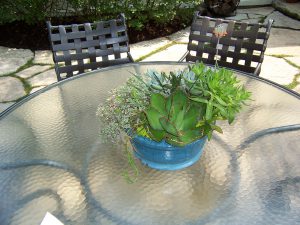
Succulents photo by Nina Koziol

